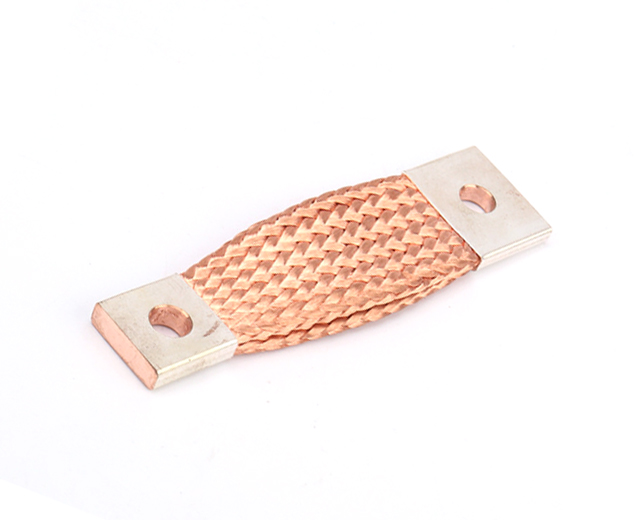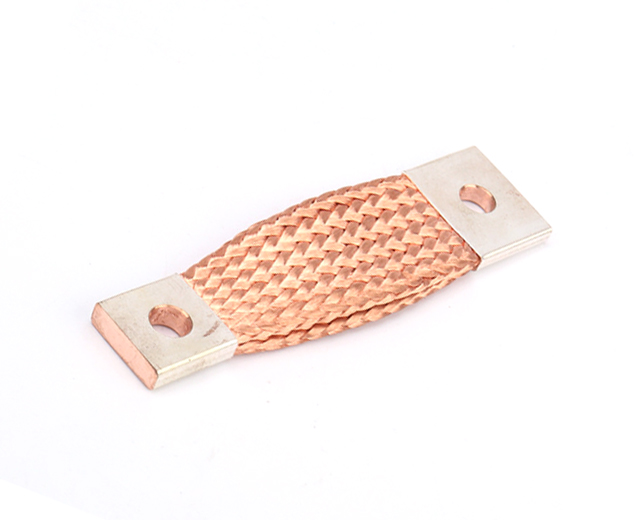

A copper braided busbar, also known as a flexible copper busbar or braided busbar, is a type of electrical conductor designed to transmit high current while providing mechanical flexibility. Unlike traditional rigid copper busbars, the flexible braided copper busbar consists of multiple fine copper strands woven together, forming a braid that can bend and absorb vibration without compromising electrical performance.
These components are widely used in power distribution systems, switchgear, battery packs, UPS systems, and industrial machinery, where movement, thermal expansion, or vibration could damage rigid bus bars.

The production of a flexible braided busbar involves several precise steps:
Material Selection
High-purity oxygen-free copper strands are selected to ensure excellent conductivity and mechanical durability.
Stranding & Braiding
Multiple copper wires are braided or twisted together to form a flexible conductor, maintaining low electrical resistance while enhancing flexibility.
End Termination
Copper braid ends are pressed, soldered, or laminated with copper terminals to ensure a secure connection.
Surface Treatment
Tin plating, silver plating, or nickel plating is applied to prevent oxidation and improve electrical contact.
Quality Inspection
Each flexible braided copper busbar is tested for current carrying capacity, mechanical flexibility, and insulation compatibility before shipment.
The braided structure allows the busbar to absorb vibrations, thermal expansion, and mechanical shocks, making it ideal for dynamic electrical systems.
Compared to rigid copper busbars, our flexible braided busbars offer significant advantages:
| Feature | Description | Benefit |
|---|---|---|
| High Flexibility | Braided copper strands allow bending without breaking | Ideal for moving parts or vibration-prone systems |
| Superior Conductivity | High-purity copper strands | Efficient current transmission with minimal power loss |
| Vibration & Thermal Compensation | Absorbs thermal expansion and mechanical stress | Reduces fatigue and connection failure |
| Customizable Dimensions | Thickness, width, and braid patterns | Meets exact electrical and mechanical requirements |
| Corrosion-Resistant | Tin, silver, or nickel plating | Long service life even in humid or corrosive environments |
| Low Inductance & Resistance | Multiple parallel strands | Improved performance in high-current applications |
| Material | Description | Application |
|---|---|---|
| Copper (C1100, C1020) | High-purity, high-conductivity copper strands | Standard power distribution, UPS, switchgear |
| Plating | Tin, nickel, or silver | Oxidation protection, enhanced contact |
| Optional Insulation | PVC, Teflon, or silicone sleeve | Electrical isolation and protection |
| Parameter | Range / Option | Description |
|---|---|---|
| Thickness | 2 mm – 15 mm | Depends on current rating and strand number |
| Width | 10 mm – 100 mm | Standard or customized widths available |
| Current Capacity | 50 A – 3000 A | Depends on cross-sectional area and braid density |
| Voltage Rating | Up to 1500 V | For medium and high-voltage systems |
| Surface Treatment | Tin, Nickel, Silver Plated | Prevents oxidation and enhances conductivity |
| Operating Temperature | –40°C to +125°C | Suitable for industrial and EV applications |
flexible copper busbars and braided busbars are widely used across multiple industries:
Switchgear & Control Panels – Absorb vibration and thermal expansion in high-current circuits.
UPS & Power Distribution Units – Reliable connections in dynamic electrical systems.
Battery Packs & EVs – Safe and flexible high-current connections.
Industrial Machinery – Connects moving or rotating components without fatigue.
Renewable Energy Systems – Solar inverters, wind turbine converters, and hybrid energy systems.
Ensure proper torque on all terminals for stable electrical connection.
Avoid excessive bending beyond recommended radius to prevent strand damage.
Keep surfaces clean and free from oils or debris.
Inspect regularly for corrosion, fatigue, or loosening in high-vibration environments.
Use appropriate insulation sleeves if required for safety and protection.
Proper installation and maintenance ensure long-term performance and electrical safety.
As a professional bus bar manufacturer specializing in copper braided busbars:
Custom Fabrication – We design braided busbars to your exact dimensions, current rating, and connection style.
Premium Materials – High-purity copper and advanced plating ensure superior conductivity and durability.
Advanced Manufacturing – CNC braiding machines and quality inspection guarantee precise, reliable products.
Global Compliance – ISO9001, RoHS, UL standards.
Technical Support & Fast Delivery – Our team provides OEM/ODM services with quick response times.
We deliver high-performance flexible copper busbars that outperform rigid or low-quality alternatives in flexibility, durability, and current capacity.
Q1: What is the difference between a flexible copper busbar and a standard copper busbar?
A: A flexible copper busbar is made of braided strands, providing mechanical flexibility and vibration resistance, while standard copper busbars are rigid and cannot absorb movement.
Q2: Can flexible braided busbars carry high currents?
A: Yes. Depending on braid thickness and width, they can handle currents from 50A to 3000A.
Q3: What plating options are available?
A: Tin, nickel, or silver plating is available for oxidation resistance and enhanced conductivity.
Q4: Are custom sizes available?
A: Yes. We can fabricate braided busbars in custom thickness, width, length, and terminal configurations.
Q5: How should I maintain a flexible braided busbar?
A: Inspect regularly, avoid excessive bending, ensure proper torque on terminals, and keep surfaces clean for long service life.